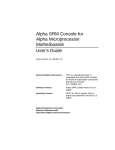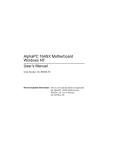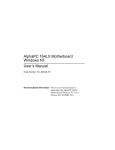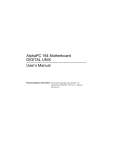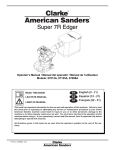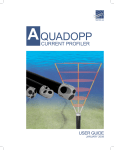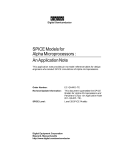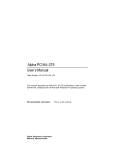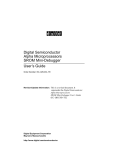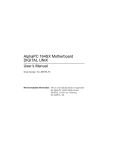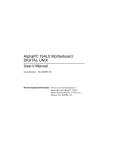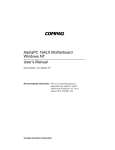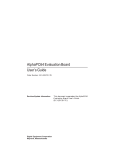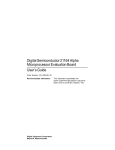Download Microsoft Windows NT 4.0 Guide Installation guide
Transcript
Alpha Microprocessors Motherboard Windows NT 3.51 and 4.0 Installation Guide Order Number: EC–QLUAH–TE Revision/Update Information: This is a revised document. It supersedes the Alpha Microprocessors Motherboard Windows NT 3.51 and 4.0 Installation Guide, EC–QLUAG–TE. Software: Microsoft Windows NT Workstation and Windows NT Server Digital Equipment Corporation Maynard, Massachusetts http://www.digital.com/semiconductor October 1997 While DIGITAL believes the information included in this publication is correct as of the date of publication, it is subject to change without notice. © Digital Equipment Corporation 1997. All rights reserved. Printed in U.S.A. AlphaPC, DIGITAL, DIGITAL Semiconductor, DIGITAL UNIX, and the DIGITAL logo are trademarks of Digital Equipment Corporation. DIGITAL Semiconductor is a Digital Equipment Corporation business. CompuServe is a registered trademark of CompuServe, Inc. Linux is a registered trademark of Croce, William R. Della, Jr. Microsoft, MS-DOS, and Windows are registered trademarks and Windows NT is a trademark of Microsoft Corporation. PS/2 is a registered trademark of International Business Machines Corporation. QLogic is a registered trademark and ISP is a trademark of QLogic Corporation. All other trademarks and registered trademarks are the property of their respective owners. Contents Preface .................................................................................................................................v 1. Requirements ................................................................................................................1 1.1 Hardware............................................................................................................1 1.2 Software..............................................................................................................2 2. AlphaBIOS.....................................................................................................................3 2.1 AlphaBIOS Conventions ....................................................................................3 2.2 Starting the AlphaBIOS Setup Program ...........................................................4 2.3 Upgrading AlphaBIOS .......................................................................................5 2.4 Performing CMOS Setup Tasks .........................................................................5 2.4.1 Setting Up Your Hard Disk.....................................................................6 2.4.2 Displaying Your System Configuration ..................................................7 2.4.3 Running a Maintenance Program...........................................................9 2.5 Installing the Windows NT Operating System................................................11 2.5.1 Before Installing Windows NT ..............................................................11 2.5.2 Starting Windows NT Setup .................................................................11 3. Windows NT ARC Firmware.......................................................................................12 3.1 Firmware Conventions.....................................................................................13 3.2 Firmware Menus Access ..................................................................................13 3.3 Firmware Menus Structure .............................................................................14 3.4 Firmware Menus Descriptions.........................................................................16 3.4.1 Boot Menu .............................................................................................16 3.4.2 Supplementary Menu............................................................................17 3.4.3 Setup Menu ...........................................................................................18 3.4.4 Boot Selections Menu ............................................................................21 3.4.5 Machine Specific Setup Menu ...............................................................23 3.5 Firmware Update Utility..................................................................................24 3.5.1 Updating Firmware in a Flash ROM ....................................................24 3.5.2 Updating Firmware in a UVPROM ......................................................25 3.6 Disk Partition Utility .......................................................................................25 3.6.1 Using the Disk Partition Utility............................................................26 3.6.2 Creating the System Partition ..............................................................26 3.7 Installing the Windows NT Operating System................................................27 3.7.1 Before Installing Windows NT ..............................................................27 iii 3.7.2 Starting Windows NT Setup................................................................. 28 4. Troubleshooting .......................................................................................................... 29 4.1 Beep Codes....................................................................................................... 31 4.2 Post Codes........................................................................................................ 33 4.3 Fail-Safe Booter ............................................................................................... 44 4.3.1 Starting the Fail-Safe Booter ............................................................... 44 5. Support, Products, and Documentation ..................................................................... 46 5.1 DIGITAL Semiconductor Products.................................................................. 47 5.2 DIGITAL Semiconductor Documentation ....................................................... 48 5.3 Ordering Third-Party Software and Documentation...................................... 50 5.4 Obtaining the Hardware Compatibility List for Windows NT........................ 50 Figure 1 Figure 2 Figure 3 Figure 4 Figure 5 AlphaBIOS Boot Screen................................................................................ 4 Display System Configuration...................................................................... 8 Run Maintenance Program Submenu .......................................................... 9 Entering the Program Name ...................................................................... 10 Windows NT ARC Firmware Menus .......................................................... 15 Table 1 Computer Types and Installation Diskette Requirements for Windows NT 3.51.......................................................................................... 28 Table 2 Computer Types and Installation Diskette Requirements for Windows NT 4.0 ........................................................................................... 28 Table 3 Beep Codes for AlphaPC 164SX ................................................................... 31 Table 4 Beep Codes for AlphaPC 164LX ................................................................... 31 Table 5 Beep Codes for AlphaPC 164 ........................................................................ 32 Table 6 Beep Codes for EB164................................................................................... 32 Table 7 Post Codes for AlphaPC 164SX .................................................................... 33 Table 8 Post Codes for AlphaPC 164LX .................................................................... 35 Table 9 Post Codes for AlphaPC 164 ......................................................................... 37 Table 10 Post Codes for EB164.................................................................................. 39 Table 11 Post Codes for AlphaPC 64 ......................................................................... 41 Table 12 Post Codes for EB66+ ................................................................................. 42 Table 13 Post Codes for EB66.................................................................................... 43 iv Preface This document describes how to install the Microsoft Windows NT Workstation and Microsoft Windows NT Server operating systems on the following Alpha microprocessor motherboards: • AlphaPC 164SX Motherboard (AlphaPC 164SX) • AlphaPC 164LX Motherboard (AlphaPC 164LX) • AlphaPC 164 Motherboard (AlphaPC 164) • Alpha 21164 Evaluation Board (EB164) • AlphaPC 64 Evaluation Board (AlphaPC 64) • Alpha 21066A Evaluation Board (EB66+) • Alpha 21064 and Alpha 21064A PCI Evaluation Board (EB64+) • Alpha 21066 and Alpha 21068 Evaluation Board (EB66) The DIGITAL Semiconductor AlphaPC 164SX and AlphaPC 164LX motherboards run new firmware called AlphaBIOS. The DIGITAL Semiconductor AlphaPC 164, EB164, AlphaPC 64, EB66+, EB64+, and EB66 motherboards run the Windows NT ARC firmware. DIGITAL recommends that you read this entire document before installing the Windows NT Workstation or Windows NT Server operating system. Windows NT Installation Guide v Document Conventions and Terms In this document, the term motherboard refers to the AlphaPC 164SX Motherboard, the AlphaPC 164LX Motherboard, the AlphaPC 164 Motherboard, the EB164 Evaluation Board, the AlphaPC 64 Evaluation Board, the EB66+ Evaluation Board, the EB64+ Evaluation Board, and the EB66 Evaluation Board, unless otherwise noted. The following conventions are used in this document: Convention Description boldface type Boldface type in text indicates a command or menu selection. Caution Cautions contain information to prevent damage to software or hardware. Italic type Italic type emphasizes important information and indicates complete titles of manuals. Note: Notes provide additional information about a topic. The following terms are used in this document: Term Description AlphaBIOS A new enhanced Basic Input Output System (BIOS) for certain Alpha system families based on the Alpha processor Alpha SDK and firmware update compact disc The compact disc labeled Alpha Motherboards Software Developer’s Kit and Firmware Update ARC firmware Advanced RISC Computing (ARC) firmware Microsoft Windows NT installation guide The Windows NT Workstation Installation Guide and the Windows NT Server Installation Guide Motherboard An Alpha microprocessor motherboard System All of the hardware and software components associated with an Alpha microprocessor motherboard Windows NT The Microsoft Windows NT Workstation and Windows NT Server operating systems vi Windows NT Installation Guide Related Documentation Documentation referenced in this document, such as the Alpha Motherboards Software Developer’s Kit and Firmware Update Read Me First and platformspecific README files can be found on the Alpha SDK and firmware update compact disc. See Section 5 for information about ordering related documentation. Windows NT Installation Guide vii 1. Requirements This section describes the hardware, software, and firmware requirements to install and boot Windows NT on Alpha microprocessor motherboard systems. 1.1 Hardware You need the following hardware to run Windows NT on Alpha motherboard systems: • A supported video adapter and monitor • A 166MB (or larger) hard drive Note: For information about IDE/ATA hard drives, ATAPI CD–ROM drives, and support for QLogic ISP 1020 SCSI host adapters, see the platform-specific READNT.TXT file on the Alpha SDK and firmware update compact disc or the platform-specific README.TXT file on the Windows NT firmware installation diskette. • A SCSI or ATAPI CD–ROM drive • A 3.5-in, 1.44MB diskette drive • A PS/2 keyboard • Memory: • − 16MB of memory (RAM) is required for the Windows NT Workstation operating system; 32MB is recommended − 32MB of memory (RAM) is required for the Windows NT Server operating system Optional components: − A PS/2 mouse or other supported pointing device − One or more supported network adapters if you want to use Windows NT on a network To obtain the hardware compatibility list for Windows NT, see Section 5.4. Windows NT Installation Guide 1 1.2 Software You need different software to install Windows NT on an Alpha motherboard system running AlphaBIOS firmware than on an Alpha motherboard system running Windows NT ARC firmware. AlphaPC 164SX and AlphaPC 164LX You need the following software to install Windows NT on the AlphaPC 164SX and the AlphaPC 164LX. Software Vendor Microsoft Windows NT compact disc Microsoft Corporation AlphaBIOS Firmware diskette Digital Equipment Corporation Windows NT 4.0 Installation diskette Digital Equipment Corporation AlphaPC 164, EB164, AlphaPC 64, EB66+, EB64+, and EB66 You need the following software to install Windows NT on the AlphaPC 164, EB164, AlphaPC 64, EB66+, EB64+, and EB66. Software Vendor Microsoft Windows NT compact disc Microsoft Corporation Manufacturer-supplied hardware support files Digital Equipment Corporation 1 Update and Windows NT ARC firmware diskette 1 Digital Equipment Corporation Depending on your computer type, this diskette may or may not be required for Windows NT. See Table 1 and Table 2 to determine if your computer type requires an installation diskette. Future versions of Windows NT may not require this diskette. Contact your OEM or system vendor for details. 2 Windows NT Installation Guide 2. AlphaBIOS The AlphaPC 164SX and the AlphaPC 164LX motherboards ship with AlphaBIOS firmware and online documentation that describes how to configure the firmware for Windows NT. This firmware initializes the system and enables you to install and boot the Windows NT operating system. The AlphaBIOS firmware resides in the flash ROM on the motherboard. 2.1 AlphaBIOS Conventions AlphaBIOS uses the following keys and key combinations for navigating the interface and selecting items. If you are familiar with MS-DOS or Microsoft Windows keyboard conventions, navigating AlphaBIOS is simple. Key or Key Combination Description Tab Move highlight forward between fields of a dialog. Shift + Tab Move highlight backwards between fields of a dialog. ↓ or ↑ Move highlight within a menu, or cycle through available field values in a dialog window. Alt + ↓ Drop down a menu of choices from a drop-down listbox. A dropdown listbox can be recognized by the symbol ⇓. Home Move to the beginning of a text entry field. End Move to the end of a text entry field. ← or → Move to the left or right in a text entry field. Esc Discard changes and back up to previous screen. Windows NT Installation Guide 3 Two levels of keyboard help are available: • Press F1 once to display explanations of the keystrokes available for the currently displayed part of AlphaBIOS. • Press F1 twice to display explanations of the keystrokes available for navigating throughout AlphaBIOS. 2.2 Starting the AlphaBIOS Setup Program When you power up or reset your system, the boot screen with the system logo is displayed. Figure 1 shows an example of an AlphaBIOS Boot Screen with the “Press <F2> to enter SETUP” message at the bottom. Press F2 to start the AlphaBIOS setup program. Figure 1 AlphaBIOS Boot Screen 4 Windows NT Installation Guide 2.3 Upgrading AlphaBIOS As new versions of Windows NT are released, it might be necessary to upgrade AlphaBIOS to the latest version. Additionally, as improvements are made to AlphaBIOS, it might be desirable to upgrade to take advantage of new features. To upgrade from an earlier version of AlphaBIOS: 1. Insert the diskette or CD–ROM containing the AlphaBIOS upgrade. 2. Run the AlphaBIOS Setup program by restarting your system and pressing F2 when the boot screen is displayed. 3. In the main AlphaBIOS Setup screen, select Upgrade AlphaBIOS and press Enter. This menu option is used to upgrade to later versions of AlphaBIOS. When you choose this option, the existing AlphaBIOS searches for an executable AlphaBIOS update file, first on CD–ROM, then on diskette. Once the update file has been found, AlphaBIOS executes it, and the firmware is upgraded. 4. After the upgrade is complete, the system either resets automatically or prompts you to reset it. 2.4 Performing CMOS Setup Tasks CMOS Setup is divided into two modes, standard and advanced. The following table lists the tasks that you can perform in standard and advanced setup mode. Standard CMOS Setup Advanced CMOS Setup Autostart Memory test Date and time PCI parity Floppy Password protection Keyboard SCSI termination SCSI BIOS emulation Windows NT Installation Guide 5 To enter standard CMOS Setup: 1. Start AlphaBIOS Setup. 2. Select CMOS Setup. 3. Press Enter. To enter advanced CMOS Setup: 1. Start AlphaBIOS Setup. 2. Select CMOS Setup. 3. Press Enter. 4. In the CMOS Setup screen, press F6. 2.4.1 Setting Up Your Hard Disk Express hard-disk setup is an easy way to create the recommended partition arrangement on your first hard disk, disk 0. Note, however, that express harddisk setup does not format the large partition with NTFS. You will have the opportunity to do this during the Windows NT installation. Note: AlphaBIOS assigns “disk 0” to the hard disk with the lowest SCSI ID number on the first bus in your system. If no SCSI devices are present, AlphaBIOS assigns disk 0 to the first IDE hard drive. Caution: If you have any information on your disk that you want to save, be sure to back it up before using express hard-disk setup. To perform express hard-disk setup: 1. Start AlphaBIOS Setup. 2. Select Hard Disk Setup. 3. Press Enter. 4. Press F7 to enter express hard-disk setup. 5. Press F10 to continue with the setup. 6 Windows NT Installation Guide For information on manually managing hard disks, see the online documentation. 2.4.2 Displaying Your System Configuration You can use AlphaBIOS to display your system configuration in a clear, easy-toread format, organized by categories: system board, memory, hard disk, PCI, SCSI, and peripherals. To display your system configuration: 1. Start AlphaBIOS Setup. 2. Select Display System Configuration. 3. Press Enter. 4. In the Display System Configuration screen (see Figure 2), use the arrow keys to select the configuration category that you want to see. Windows NT Installation Guide 7 Figure 2 Display System Configuration 8 Windows NT Installation Guide 2.4.3 Running a Maintenance Program You can run maintenance programs such as RAID and other configuration utilities directly from the AlphaBIOS utility menu. To run a maintenance program: 1. Start AlphaBIOS Setup. 2. Select Utilities. 3. Select Run Maintenance Program from the submenu shown in Figure 3. 4. Press Enter. Figure 3 Run Maintenance Program Submenu Windows NT Installation Guide 9 5. In the Run Maintenance Program dialog box, type the name of the program to be run at the Program Name prompt, as shown in Figure 4. Then tab to the Location listbox and select the hard-disk partition, floppy diskette, or CD–ROM drive from which to run the program. 6. Press Enter to execute the program. Figure 4 Entering the Program Name If you are running a utility from a floppy diskette, you can simply type the utility’s name into the Program Name field, and press Enter. This is because the floppy drive is the default selection in the Current Partition field. Use Alt + ↓ when a listbox is selected to open the list. 10 Windows NT Installation Guide 2.5 Installing the Windows NT Operating System This section supplements the Microsoft Windows NT installation guide for installing the Windows NT operating system on an AlphaPC 164SX and the AlphaPC 164LX systems. If you have a previous version of Windows NT installed, see the Microsoft Windows NT installation guide for information about how to upgrade to a new version of the operating system. 2.5.1 Before Installing Windows NT Before installing Windows NT, ensure that you have completed the following tasks: • Use the CMOS Setup program to: − Set the system date and time. − Verify that all other standard CMOS settings match your system. Refer to Section 2.4 for more information about the CMOS Setup program. • Perform an express hard-disk setup. This configures the first hard disk that AlphaBIOS detects in your system with the recommended default partition arrangement. See Section 2.4.1 for more information on setting up your hard disk. If you do not want to use the express hard-disk setup, refer to the online AlphaBIOS documentation for other hard-disk setup options. 2.5.2 Starting Windows NT Setup Windows NT Setup, located on the Microsoft Windows NT compact disc, installs the Windows NT operating system. Windows NT Setup provides a brief description of available key functions at the bottom of the screen. During the Windows NT installation procedure, you may be prompted for the type of computer that you have. For the AlphaPC 164SX system, choose DIGITAL AlphaPC 164SX. For the AlphaPC 164LX system, choose DIGITAL AlphaPC 164LX. If the appropriate system is not shown, choose “other” after you have inserted the system-specific Windows NT 4.0 Installation diskette. The Windows NT Installation Guide 11 following procedure supersedes the Starting Setup on a RISC-Based Computer section of the Microsoft Windows NT installation guide. To start the Windows NT Setup program: 1. Insert the Windows NT compact disc in the CD–ROM drive. 2. Restart your computer. 3. Start AlphaBIOS Setup. 4. Select Install Windows NT. 5. Press Enter. 6. Follow the instructions on the screen. 3. Windows NT ARC Firmware This section describes how to use and update the Windows NT ARC firmware. This firmware is provided on your Alpha SDK and firmware update compact disc and is required to install and boot Windows NT on the following Alpha motherboard systems: AlphaPC 164, EB164, AlphaPC 64, EB66+, EB64+, and EB66. The Windows NT ARC firmware initializes the system and enables you to install and boot Windows NT. Depending on the type of motherboard you have, the firmware resides in either a flash ROM or a UVPROM. Updating to the newest firmware allows you to take advantage of new functionality. The following table lists the minimum ARC firmware version required for running Windows NT. To determine if your firmware requires updating, compare the minimum firmware version for your system with the version displayed in the firmware menus. 12 Windows NT Installation Guide System Minimum Firmware Version AlphaPC 164 4.49-4 EB164 4.35 AlphaPC 64 3.5-10 EB66+ 3.5-10 EB64+ 3.5-4 (H1.6) EB66 3.5-4 (H1.7) Note: Firmware versions that are earlier than the minimum firmware versions shown in the previous table must be updated before the installation. 3.1 Firmware Conventions To select and choose different options in the Windows NT ARC firmware menus, use the following keys: Key Description Arrow The arrow keys are used to select different options. Enter The Enter key is used to choose the highlighted option. Esc The Esc key is used to close a menu or cancel an operation. 3.2 Firmware Menus Access When you power up your system, the firmware displays a blue screen on the monitor, initializes the firmware drivers, and displays the Boot menu, the first menu of the Windows NT ARC firmware menus. The currently selected option in the menu is highlighted. Note: If autoboot is enabled, you must cancel autoboot to interact with the firmware. To cancel autoboot, press the Esc key before the timeout period expires. Windows NT Installation Guide 13 3.3 Firmware Menus Structure Figure 5, which appears on the following page, shows the structure of the Windows NT ARC firmware menus. Note: The text of some of the options may differ, and some options may not always be available. 14 Windows NT Installation Guide Boot menu: Boot Windows NT Boot an alternate operating system... Run a program... Supplementary menu... Supplementary menu: Install new firmware... Install Windows NT from CD-ROM Setup the system... Display hardware configuration Boot menu... Note: Arrows indicate flow between menu screens. This symbol... Setup menu: Set the time... Set default environment variables... Set default configuration... Set system language... Manage boot selection menu... Setup autoboot... Machine specific setup... Edit environment variables... Reset system to factory defaults... Help Supplementary menu, and do not save changes... Supplementary menu, and save changes... Boot selections menu: Add a boot selection... Change a boot selection... Verify boot selections... Delete a boot selection... Dumps boot selections Rearrange boot selections... Setup the system Means... Takes you to a submenu Machine specific setup menu: Switch Operating System... Partition Disks... Setup menu... Returns you to the previous menu in the hierarchy Figure 5 Windows NT ARC Firmware Menus Windows NT Installation Guide 15 3.4 Firmware Menus Descriptions This section describes the Windows NT ARC firmware menus and the options on the menus. (See Figure 5.) 3.4.1 Boot Menu This section describes the Boot menu options. Boot menu . . . Boot Windows NT È Boots the default boot selection. The name of your default boot selection appears in place of the string “Windows NT.” Boot menu . . . Boot an alternate operating system . . . È Provides a menu of all boot selections; choose one to boot the system. Boot menu . . . Run a program . . . È Runs an ARC application. This option prompts you for the path to the application and runs it. Boot menu . . . Supplementary menu. . . È Takes you to the Supplementary menu. 16 Windows NT Installation Guide 3.4.2 Supplementary Menu This section describes the Supplementary menu options. Boot menu . . . Supplementary menu . . . Install new firmware . . . È È Runs the firmware update program. Note: If you want to update firmware on an EB64+ or EB66 motherboard, see Section 3.5.2. Otherwise, you can update firmware using a CD–ROM or diskette. The firmware update utility is provided only on a compact disc; a diskette is not provided. For information about how to create a firmware update diskette, see the Alpha Motherboards Software Developer’s Kit and Firmware Update Read Me First. Load either the compact disc or the diskette in the appropriate drive. Choose Install new firmware to start the firmware update utility. Your system will appear to restart as the firmware update utility reinitializes the system. See Section 3.5 for directions on how to update your firmware once the firmware update utility has started. Boot menu . . . Supplementary menu . . . Install Windows NT from CD-ROM È È Starts an installation of Windows NT from a CD–ROM. See Section 3.7 for more information about installing Windows NT. Windows NT Installation Guide 17 Boot menu . . . Supplementary menu . . . Setup the system . . . È È Takes you to the Setup menu. Boot menu . . . Supplementary menu . . . Display hardware configuration È È Displays your hardware configuration in three screens. The first screen displays information about your processor and memory, as well as the firmware version. The second screen displays the name of the firmware-supported devices that were detected. The third screen displays information about PCI devices found in your system. Boot menu . . . Supplementary menu . . . Boot menu . . . È È Returns you to the Boot menu. 3.4.3 Setup Menu This section describes the Setup menu options. Boot menu . . . Supplementary menu . . . Setup the system . . . Set the time . . . È È È Allows you to set the system date and time. 18 Windows NT Installation Guide Boot menu . . . Supplementary menu . . . Setup the system . . . Set default environment variables . . . È È È Allows you to set the default system partition. The system partition is the disk partition where the Windows NT osloader, PALcode, and HAL reside. Choosing this option removes all current boot selections. If you are unsure of the values for your system, use the following typical values: Media: SCSI bus number: SCSI ID: Partition: SCSI Hard Disk 0 0 1 Boot menu . . . Supplementary menu . . . Setup the system . . . Set default configuration . . . È È È Allows you to describe your system’s monitor resolution, diskette capacity, keyboard type, and SCSI host ID to the firmware. If you are unsure of the values for your system, use the following typical values: Monitor resolution: First diskette drive capacity: Second diskette drive capacity: Keyboard: SCSI host ID: 1024 x 768 3.5” 1.44MB None U.S. 101-key keyboard 7 Note: SCSI host ID refers to the SCSI ID of the SCSI host adapter on a given SCSI bus. Windows NT Installation Guide 19 Boot menu . . . Supplementary menu . . . Setup the system . . . Set system language . . . È È È Allows you to specify the language that you want to use while interacting with the firmware. American English is the only language built into the firmware. If you want to use another language, ensure that your firmware language support disk is in your diskette drive before choosing this option. Boot menu . . . Supplementary menu . . . Setup the system . . . Manage boot selection menu . . . È È È Takes you to the Boot selections menu. Boot menu . . . Supplementary menu . . . Setup the system . . . Setup autoboot . . . È È È Allows you to specify whether or not the system should autoboot your default boot selection. If you choose to autoboot, you will also be prompted for the number of seconds to wait before autoboot should occur. Boot menu . . . Supplementary menu . . . Setup the system . . . Machine specific setup . . . È È È Takes you to the Machine specific setup menu. Boot menu . . . Supplementary menu . . . Setup the system . . . Edit environment variables . . . È È È Allows you to edit the firmware environment. 20 Windows NT Installation Guide Boot menu . . . Supplementary menu . . . Setup the system . . . Reset system to factory defaults . . . È È È Resets all options to the factory defaults. Boot menu . . . Supplementary menu . . . Setup the system . . . Help È È È Provides rudimentary help for the Setup menu. Boot menu . . . Supplementary menu . . . Setup the system . . . Supplementary menu, and do not save changes . . . È È È Returns you to the Supplementary menu, discarding any changes made from the Setup menu. Boot menu . . . Supplementary menu . . . Setup the system . . . Supplementary menu, and save changes . . . È È È Returns you to the Supplementary menu, saving any changes made from the Setup menu. Note that if you have not made any changes, this option might not appear. 3.4.4 Boot Selections Menu This section describes the Boot selections menu options. Windows NT Installation Guide 21 Boot menu . . . Supplementary menu . . . Setup the system . . . Manage boot selection menu . . . Add a boot selection . . . È È È È Allows you to manually add a new boot selection (usually you do not need to do this because installing Windows NT will automatically add a boot selection for the newly installed operating system). Boot menu . . . Supplementary menu . . . Setup the system . . . Manage boot selection menu . . . Change a boot selection . . . È È È È Allows you to modify a boot selection. Boot menu . . . Supplementary menu . . . Setup the system . . . Manage boot selection menu . . . Verify boot selections . . . È È È È Checks your boot selections and reports any problems found. Boot menu . . . Supplementary menu . . . Setup the system . . . Manage boot selection menu . . . Delete a boot selection . . . È È È È Allows you to delete a boot selection from a list of all boot selection names. 22 Windows NT Installation Guide Boot menu . . . Supplementary menu . . . Setup the system . . . Manage boot selection menu . . . Dumps boot selections È È È È Displays all your boot selections. Boot menu . . . Supplementary menu . . . Setup the system . . . Manage boot selection menu . . . Rearrange boot selections . . . È È È È Allows you to rearrange your boot selections, changing which is the default boot selection. Boot menu . . . Supplementary menu . . . Setup the system . . . Manage boot selection menu . . . Setup the system È È È È Returns you to the Setup menu. 3.4.5 Machine Specific Setup Menu This section describes the Machine specific setup menu options. Boot menu . . . Supplementary menu . . . Setup the system . . . Machine specific setup . . . Switch Operating System . . . È È È È Switch which firmware is active on reset or power-up. Windows NT Installation Guide 23 Boot menu . . . Supplementary menu . . . Setup the system . . . Machine specific setup . . . Partition Disks . . . È È È È Starts the disk partition utility. See Section 3.6 for information about this utility. Boot menu . . . Supplementary menu . . . Setup the system . . . Machine specific setup . . . Setup menu . . . È È È È Returns you to the Setup menu. 3.5 Firmware Update Utility If you have an EB64+ or EB66 motherboard, see Section 3.5.2 for directions on how to update your firmware. 3.5.1 Updating Firmware in a Flash ROM The following procedure updates the flash ROM using the firmware update utility. (To start the firmware update procedure, see Section 3.4.2.) 1. From the Firmware Update menu, choose whichever selection appears: • Update Windows NT ARC firmware. • Update Firmware. 2. When prompted to continue the update, choose Yes. If the console selection does not match the firmware that you flashed, you will be prompted to update the console selection. 3. If you are prompted to update the console selection, choose Yes. 4. When the update has completed, restart your computer. 24 Windows NT Installation Guide 3.5.2 Updating Firmware in a UVPROM If you do not have an EB64+ or EB66 motherboard, see Section 3.5.1 for directions on how to update your computer type’s firmware. The Windows NT ARC firmware is provided only on the compact disc; a UVPROM is not provided. To program your own UVPROM, see the Alpha Motherboards Software Developer’s Kit and Firmware Update Read Me First. Replacing the UVPROM To update the firmware on a motherboard after you have programmed your UVPROM, follow this procedure: 1. Power off the system. 2. Locate and, noting the correct orientation of the ROM, remove one of the UVPROMs from the motherboard. 3. Using the correct orientation, insert the new Windows NT ARC firmware UVPROM. 4. Select the new Windows NT ARC firmware UVPROM device with the UVPROM select jumper, as described in the motherboard’s user’s guide. 5. Power on the system. 3.6 Disk Partition Utility The disk partition utility, which first appears in Windows NT ARC firmware Version 4.48, is used to partition your hard drive and to format a partition with a FAT file system. The disk partition utility also displays information about the drive, such as the manufacturer and model ID strings and the ARC path. See Section 3.4.5 for instructions on how to start the disk partition utility. Windows NT Installation Guide 25 Function Keys The following table lists the disk partition utility function keys and their functions: Key Description ↑ or ↓ Change selections in the active cell. ← or → Change the active cell. Esc Exits the disk partition utility. Keyboard commands Listed in the Keyboard Commands box. To perform a specific action on the current selection, type the key associated with the action. Help The disk partition utility provides context-sensitive on-screen help. The keyboard commands available for the current selection in the active cell are shown in the Keyboard Commands box. 3.6.1 Using the Disk Partition Utility When you start the disk partition utility, the default selection is the first partition on the first disk on your system. If no partitions exist on that disk, the default selection is the unpartitioned space on the first disk. Note: Although the disk partition utility displays changes immediately, partition changes are not actually committed until you either exit the utility or perform an action that requires the changes to be committed, such as formatting. You will always be prompted for confirmation before changes are committed. 3.6.2 Creating the System Partition To make a partition the system partition, select the partition and type S. 26 Windows NT Installation Guide 3.7 Installing the Windows NT Operating System This section supplements the Microsoft Windows NT installation guide for installing the Windows NT operating system on the AlphaPC 164, EB164, AlphaPC 64, EB66+, EB64+, and EB66. If you have a previous version of Windows NT installed, see the Microsoft Windows NT installation guide for information about how to upgrade to a new version of the operating system. 3.7.1 Before Installing Windows NT Before you install Windows NT, ensure that you have completed the following tasks: • Defined the environment variables for the default system partition. For more information about describing your system configuration, see the description for Set default environment variables . . . in Section 3.4.3. • Described your system configuration to the firmware. For more information about describing your system configuration, see the description for Set default configuration . . . in Section 3.4.3. • Provided the required system partition on your hard disk. For more information on creating the system partition, see Section 3.4.5. The following table specifies the free space and file-system requirements for installing Windows NT: 1 Item Free Space Required File-System Requirement System partition 5MB FAT Windows NT 161MB FAT or NTFS 1 System partition must be FAT. The system partition is the disk partition that contains the hidden files OSLOADER.EXE and HAL.DLL in the subdirectory \OS\WINNT351. If the system partition is large enough, it can also contain Windows NT, or you may choose to use a separate partition. The system partition and Windows NT may be on different hard disks. Windows NT Installation Guide 27 3.7.2 Starting Windows NT Setup Windows NT Setup, located on the Microsoft Windows NT compact disc, installs Windows NT. Windows NT Setup provides a brief description of the available key functions at the bottom of the screen. During the Windows NT installation procedure, you may be prompted for your computer type. Use Table 1 or Table 2 to determine your computer type and to determine whether an installation diskette is required, based on the version of Windows NT. Table 1 Computer Types and Installation Diskette Requirements for Windows NT 3.51 System Choose this system… Installation diskette required? AlphaPC 164 EB164 EB66+ EB66 Digital AlphaPC164 Alpha EB164 Alpha EB66+ Alpha EB66 Yes; create an installation diskette. AlphaPC 64 EB64+ Digital AlphaPC64 Digital AlphaPC64 No. Table 2 Computer Types and Installation Diskette Requirements for Windows NT 4.0 System Choose this system… Installation diskette required? AlphaPC 164 EB164 AlphaPC 64 EB64+ Alpha EB164 Alpha EB164 Digital AlphaPC64 Digital AlphaPC64 No. EB66+ EB66 Alpha EB66+ Alpha EB66 Yes; create an installation diskette. If your motherboard does not appear as one of the choices, then insert the update and Windows NT firmware diskette. The following procedure supersedes the Starting Setup on a RISC-Based Computer section of the Microsoft Windows NT installation guide. 28 Windows NT Installation Guide To start the Windows NT Setup program, follow this procedure: 1. Insert the Microsoft Windows NT compact disc in the CD-ROM drive. 2. Restart your computer. 3. From the Boot menu, choose Supplementary menu . . . . 4. From the Supplementary menu, choose Install Windows NT from CD–ROM. 5. Follow the instructions on the screen. Note: If you have an Alpha Windows NT driver diskette for your video card, you can use the driver to install Windows NT. Follow this procedure: 1. Choose Custom Setup. 2. Choose display type Other, and insert the graphics disk driver when asked for the manufacturer-supplied hardware support disk. 4. Troubleshooting This section provides solutions to some of the common problems that you may encounter while using the Windows NT firmware and installing Windows NT. Problem When you turn on your computer, nothing displays. Solutions Ensure that the video card is correctly connected to the monitor. Ensure that the flash ROM update procedure was performed correctly. If you have a terminal attached to COM1, check the output for error messages after verifying that the flash ROM update procedure was performed correctly. Windows NT Installation Guide 29 Problem While booting Windows NT, you receive one of the following error messages: • The required system file DISPLAY_DRIVER.DLL is bad or missing. • The required system file DISPLAY_DRIVER.SYS is bad or missing. Solutions These error messages indicate video driver problems. Use the following table to solve common video driver problems. If the... Then... Driver becomes disabled Boot the Windows NT operating system with the last known good configuration. Incorrect video driver is chosen while installing the Windows NT operating system Reinstall the Windows NT operating system with the correct driver. New video card was installed before the driver was installed Reinstall the old video card, boot the Windows NT operating system, and install the driver for the new video card. Then install the new video card and reboot the Windows NT operating system. The rest of this section provides descriptions of available beep and post codes, and instructions on how to use the fail-safe booter. 30 Windows NT Installation Guide 4.1 Beep Codes Beep codes provide error information about the motherboard. The following table lists and describes the beep codes for the AlphaPC 164SX. Table 3 Beep Codes for AlphaPC 164SX Beep Code 1 1 Description 1–2–3 This sequence represents the fail-safe booter startup 4 No valid header found in ROM; loading entire ROM 5 No memory found 6 Checksum error detected when image was read back from memory One beep and a pause, followed by two beeps and a pause, followed by three beeps. The following table lists and describes the beep codes for the AlphaPC 164LX. Table 4 Beep Codes for AlphaPC 164LX Beep Code 1 1 Description 1–2–3 This sequence represents the fail-safe booter startup 4 No valid header found in ROM; loading entire ROM 5 No memory found 6 Checksum error detected when image was read back from memory One beep and a pause, followed by two beeps and a pause, followed by three beeps. Windows NT Installation Guide 31 The following table lists and describes the beep codes for the AlphaPC 164. Table 5 Beep Codes for AlphaPC 164 Beep Code 1 1 Description 1–2–3 This sequence represents the fail-safe booter startup 4 No valid header found in ROM; loading entire ROM 5,6,7 Same meaning as AlphaPC 164 post code 3F fatal error subcodes One beep and a pause, followed by two beeps and a pause, followed by three beeps. The following table lists and describes the beep codes for the EB164. Table 6 Beep Codes for EB164 Beep Code Description 2 Jumping to system code 4 No valid header found in ROM; loading entire ROM 5,6,7 Same meaning as fatal error subcodes 32 Windows NT Installation Guide 4.2 Post Codes Post codes indicate the progress of the SROM and Windows NT firmware. The following table lists and describes the post codes for the AlphaPC 164SX. Table 7 Post Codes for AlphaPC 164SX Source Post Code (hex) Description SROM 00 Firmware initialization is complete 01 CPU speed detected 02 CPU speed converted 03 Configuration jumpers read 04 Bcache configuration value computed 05 Bcache control value computed 0C Memory sized and memory bank 0 written 0D Enable Dcache 13 All of memory rewritten (good data parity written) 14 Memory errors cleared; start reading system ROM 15 Loading ROM without SROM decompression 16 Loading ROM using SROM decompression 17 System ROM loaded to memory 18 Icache flush code written to memory 19 CPU errors cleared; jump to system code 20 ISA bus reset 3A Jump to Mini-Debugger Windows NT Installation Guide 33 Source AlphaBIOS Fail-safe booter Post Code (hex) Description 3F Fatal error. Second code identifies source of error: 05 = No memory found 06 = Checksum error detected when image was read back from memory 98 Firmware has control 97 Buses initialized 95 Video console opened 51 FATAL–returned from boot menu selection 50 FATAL–firmware fatal error 42 Firmware drivers have been started 00 Firmware has been initialized FD I/O bus initialization FC I/O initialization complete FB UART initialization BF Fail-safe booter is scanning diskette 1 Fail-safe booter is loading the Windows NT AlphaBIOS 2 Fail-safe booter is loading the Debug Monitor 3 Fail-safe booter is loading the SRM console 4 Fail-safe booter is loading the Linux miniloader 34 Windows NT Installation Guide The following table lists and describes the post codes for the AlphaPC 164LX. Table 8 Post Codes for AlphaPC 164LX Source Post Code (hex) Description SROM 00 Firmware initialization is complete 01 CPU speed detected 02 CPU speed converted 03 Configuration jumpers read 04 Bcache configuration value computed 05 Bcache control value computed 06 Bcache turned off 0C Memory sized and memory bank 0 written 0F Bcache turned on 13 All of memory rewritten (good data parity written) 14 Memory errors cleared; start reading system ROM 15 Loading ROM without SROM decompression 16 Loading ROM using SROM decompression 17 System ROM loaded to memory 18 Icache flush code written to memory 19 CPU errors cleared; jump to system code 20 ISA bus reset Windows NT Installation Guide 35 Source AlphaBIOS Fail-safe booter Post Code (hex) Description 3F Fatal error. Second code identifies source of error: 05 = No memory found 06 = Checksum error detected when image was read back from memory 98 Firmware has control 97 Buses initialized 95 Video console opened 51 FATAL–returned from boot menu selection 50 FATAL–firmware fatal error 42 Firmware drivers have been started 00 Firmware has been initialized FD I/O bus initialization FC I/O initialization complete FB UART initialization BF Fail-safe booter is scanning diskette 1 Fail-safe booter is loading the Windows NT AlphaBIOS 2 Fail-safe booter is loading the Debug Monitor 3 Fail-safe booter is loading the SRM console 4 Fail-safe booter is loading the Linux miniloader 36 Windows NT Installation Guide The following table lists and describes the post codes for the AlphaPC 164. Table 9 Post Codes for AlphaPC 164 Post Code (hex) Description 00 Firmware initialization is complete 01 CPU speed detected 02 CPU speed converted 03 Configuration jumpers read 04 Bcache configuration value computed 05 Bcache control value computed 06 Bcache turned off 07 Memory timing registers written 08 Memory control register written 09 Memory bank 0 register written 0B DRAMs awakened 0C Memory sized and memory bank 0 written 0F Bcache turned on 13 All of memory rewritten (good data parity written) 14 Memory errors cleared; start reading system ROM 15 Loading ROM without SROM decompression 16 Loading ROM using SROM decompression 17 System ROM loaded to memory 18 Icache flush code written to memory 19 CPU errors cleared; jump to system code 20 ISA bus reset Windows NT Installation Guide 37 Post Code (hex) Description 3A Jumping to SROM Mini-Debugger 3F Fatal error. Second code identifies source of error: 05 = No memory found 06 = Checksum error detected when image was read back from memory 07 = Could not determine the SIMM type 41 Firmware environment has been loaded 42 Firmware services have been initialized 50 A fatal error has occurred (FATAL) 51 The Boot menu illegally returned (FATAL) 75 System initialization is complete—start firmware setup 76 Checking system information for sanity 77 About to initialize the video subsystem 78 PCI configuration is complete; about to initialize the keyboard 79 About to configure PCI devices 80 About to initialize the PCI bus (hard restart) 81 About to initialize the PCI bus (soft restart) 85 About to validate the SCB 86 Early initialization of firmware API 87 About to initialize the system chipset 88 Initialize vendor API 89 The firmware kernel debugger module is starting 95 Video subsystem and keyboard are okay; using graphic console 38 Windows NT Installation Guide Post Code (hex) Description 96 Video or keyboard is missing or broken; using COM1 as console 97 Trying to initialize video subsystem and keyboard as graphic console 98 Serial ports have been initialized; firmware initialization is starting 99 The firmware is about to initialize the serial ports FD I/O bus initialization FC I/O initialization complete FB UART initialization BF Fail-safe booter is scanning diskette 0 Fail-safe booter is loading the firmware update utility The following table lists and describes the post codes for the EB164. Table 10 Post Codes for EB164 Post Code (hex) Description 00 ISA bus reset 01 CPU speed detected 02 CPU speed converted 03 Configuration jumpers read 04 Bcache configuration value computed 05 Bcache control value computed 06 Bcache turned off 07 Memory timing registers written Windows NT Installation Guide 39 Post Code (hex) Description 08 Memory control register written 09 Memory bank 0 register written 0B DRAMs awakened 0C Memory sized and memory bank 0 written 0F Bcache turned on 13 All of memory rewritten (good data parity written) 14 Memory errors cleared; start reading system ROM 15 Loading ROM without SROM decompression 16 Loading ROM using SROM decompression 17 System ROM loaded to memory 18 Icache flush code written to memory 19 CPU errors cleared; jump to system code 3A Jumping to SROM Mini-Debugger 3F Fatal error. Second code identifies source of error: 05 = No SIMMs found when sizing memory 06 = Checksum error detected when image was read back from memory 07 = Could not detect SIMM type during memory sizing 40 Windows NT Installation Guide The following table lists and describes the post codes for the AlphaPC 64. Table 11 Post Codes for AlphaPC 64 Post Code (hex) Description 00 ISA bus reset 01 CPU speed detected 02 CPU speed converted 05 Bcache timing parameters computed 06 BIU_CTL register written 07 Memory global timing register written 08 Memory refresh timing register written 09 Bank 0 timing register written 0A Bank 1 timing register written 0B DRAMs awakened 0C Bank 0 configuration register written 0D Bank 1 configuration register written 0E Memory general control register written 0F Bcache flushed (good tag parity written) 10 Tag enable register written 11 Final memory general control register written 12 ABOX_CTL register written 13 All of memory rewritten (good data parity written) 14 Memory errors cleared; start reading system ROM 15 Loading ROM without SROM decompression 16 Loading ROM using SROM decompression 17 System ROM loaded to memory Windows NT Installation Guide 41 Post Code (hex) Description 18 Icache flush code written to memory 19 CPU errors cleared The following table lists and describes the post codes for the EB66+. Table 12 Post Codes for EB66+ Post Code (hex) Description 00 ISA bus reset 01 CPU speed detected 03 CPU speed converted; Bcache disabled 06 Preconfigure memory banks 07 DRAMs awakened 08 Bcache timing established 09 Bcache flushed (good tag parity written) 0A Bank timing registers written 0D Bank configuration registers written 0E Bank base addresses established 10 ABOX_CTL register written 11 All of memory rewritten (good data parity written) 12 Memory errors cleared; start reading system ROM 15 Loading ROM without SROM decompression 16 Loading ROM using SROM decompression 17 System ROM loaded to memory 18 Icache flush code written to memory 19 CPU errors cleared 42 Windows NT Installation Guide The following table lists and describes the post codes for the EB66. Table 13 Post Codes for EB66 Post Code (hex) Description 00 ISA bus reset 01 CPU speed detected 02 CPU speed converted 04 Memory global timing register written 05 Read system configuration data 06 Preconfigure memory banks 07 DRAMs awakened 08 Bcache timing established 09 Bcache flushed (good tag parity written) 0A Bank 0 timing register written 0B Bank 1 timing register written 0C Bank configuration registers written 0D Bank base addresses established 0F ABOX_CTL register written 10 All of memory rewritten (good data parity written) 14 Memory errors cleared; start reading system ROM 15 Loading ROM (header located) 16 Loading ROM (image located) 17 System ROM loaded to memory 18 Icache flush code written to memory 19 CPU errors cleared Windows NT Installation Guide 43 4.3 Fail-Safe Booter The fail-safe booter, currently available for use on the AlphaPC 164SX, the AlphaPC 164LX, and the AlphaPC 164 only, provides an emergency recovery mechanism when the primary firmware image contained in flash memory has been corrupted. When flash memory has been corrupted, such that no image is safely loaded from the flash, the fail-safe booter can be run to facilitate booting another image from a diskette that is capable of reprogramming the flash. 4.3.1 Starting the Fail-Safe Booter The fail-safe booter can be started in one of two ways for each system listed below. AlphaPC 164SX and AlphaPC 164LX • If the primary firmware image is unavailable when the system is powered on or reset, the fail-safe booter runs automatically. When the fail-safe booter runs, the system emits a series of beeps through the speaker as beep code 1–2–3; this is, one beep and a pause, followed by two beeps and a pause, followed by three beeps. After the diskette activity light flashes: 1. Insert the system-specific AlphaBIOS Firmware diskette. The fail-safe booter will load and run AlphaBIOS from this diskette. 2. Go to Section 2.3 and follow the procedure for upgrading AlphaBIOS. • You can also start the fail-safe booter manually as follows: 1. Power off your system. 2. Add jumper CF7 as described in the system-specific motherboard Windows NT user’s manual. 3. Power on your system. 44 Windows NT Installation Guide 4. Insert the system-specific AlphaBIOS Firmware diskette into the diskette drive 5. Go to Section 2.3 and follow the procedure for upgrading AlphaBIOS. AlphaPC 164 • If the primary firmware image is unavailable when the system is powered on or reset, the fail-safe booter runs automatically. When the fail-safe booter runs, the system emits a series of beeps through the speaker as beep code 1–2–3; this is, one beep and a pause, followed by two beeps and a pause, followed by three beeps. After the diskette activity light flashes, insert the update and Windows NT firmware diskette containing the file FWUPDATE.EXE. • You can also start the fail-safe booter manually as follows: 1. Add jumper CF7 as described in the AlphaPC 164 Motherboard User’s Manual. 2. Insert the update and Windows NT firmware diskette into the diskette drive. 3. Go to Section 3.5 for information on how to update the flash ROM using the firmware update utility. Windows NT Installation Guide 45 5. Support, Products, and Documentation If you need technical support, a DIGITAL Semiconductor Product Catalog, or help deciding which documentation best meets your needs, visit the DIGITAL Semiconductor World Wide Web Internet site: http://www.digital.com/semiconductor You can also call the DIGITAL Semiconductor Information Line or the DIGITAL Semiconductor Customer Technology Center. Please use the following information lines for support. For documentation and general information: DIGITAL Semiconductor Information Line United States and Canada: Outside North America: Electronic mail address: 1–800–332–2717 1–510–490–4753 [email protected] For technical support: DIGITAL Semiconductor Customer Technology Center Phone (U.S. and international): Fax: Electronic mail address: 46 Windows NT Installation Guide 1–978–568–7474 1–978–568–6698 [email protected] 5.1 DIGITAL Semiconductor Products To order Alpha microprocessors and motherboards, contact your local distributor. Note: The following products and order numbers might have been revised. For the latest versions, contact your local distributor. Product Order Number DIGITAL Semiconductor Alpha 21164 600 MHz Microprocessor 21164–MB DIGITAL Semiconductor Alpha 21164 533 MHz Microprocessor 21164–P8 DIGITAL Semiconductor Alpha 21164 466 MHz Microprocessor 21164–IB Motherboard Kits Motherboard kits include the motherboard, the motherboard’s user’s manual, and firmware. Product Order Number DIGITAL Semiconductor AlphaPC 164SX Motherboard for Windows NT 21A05–A0 DIGITAL Semiconductor AlphaPC 164SX Motherboard for DIGITAL UNIX 21A05–A1 DIGITAL Semiconductor AlphaPC 164LX Motherboard for Windows NT 21A04–C0 DIGITAL Semiconductor AlphaPC 164LX Motherboard for DIGITAL UNIX 21A04–C1 DIGITAL Semiconductor AlphaPC 164 Motherboard for Windows NT 21A04–B0 DIGITAL Semiconductor AlphaPC 164 Motherboard for DIGITAL UNIX 21A04–B2 Design Kits Design kits include full documentation and schematics. They do not include motherboards or related hardware. Product Order Number DIGITAL Semiconductor AlphaPC 164 Motherboard Design Kit QR–21A04–12 Windows NT Installation Guide 47 5.2 DIGITAL Semiconductor Documentation The following table lists some of the available DIGITAL Semiconductor documentation. Title Order Number 1 Alpha AXP Architecture Reference Manual Alpha Architecture Handbook 1 2 EY–T132E–DP EC–QD2KB–TE DIGITAL Semiconductor Alpha 21164PC Microprocessor Hardware Reference Manual EC–R2W0A–TE DIGITAL Semiconductor Alpha 21164 Microprocessor Hardware Reference Manual EC–QP99B–TE DIGITAL Semiconductor AlphaPC 164SX Motherboard Product Brief EC–R57CA–TE DIGITAL Semiconductor AlphaPC 164LX Motherboard Product Brief EC–R2RZA–TE AlphaPC 164SX Motherboard Windows NT User’s Manual EC–R57DA–TE AlphaPC 164LX Motherboard Windows NT User’s Manual EC–R2ZQD–TE DIGITAL Semiconductor AlphaPC 164LX Motherboard Technical Reference Manual EC–R46WA–TE DIGITAL Semiconductor AlphaPC 164 Motherboard Product Brief EC–QUQKC–TE AlphaPC 164 Motherboard User’s Manual EC–QPG0B–TE DIGITAL Semiconductor AlphaPC 164 Motherboard Technical Reference Manual EC–QPFYB–TE To purchase the Alpha AXP Architecture Reference Manual, contact your local distributor or call Butterworth-Heinemann (Digital Press) at 1–800–366–2665. 2 This handbook provides information subsequent to the Alpha AXP Architecture Reference Manual. 48 Windows NT Installation Guide Title Order Number DIGITAL Semiconductor AlphaPC 164 Motherboard Design Kit Read Me First EC–QPFZA–TE DIGITAL Semiconductor AlphaPC 164 Motherboard DIGITAL UNIX Product Brief EC–QZT6B–TE AlphaPC 164 Motherboard DIGITAL UNIX User’s Manual EC–QZT5B–TE DIGITAL Semiconductor Alpha Motherboards Software Developer’s Kit and Firmware Update V3.1 Product Brief EC–QXQKC–TE Alpha Motherboards Software Developer’s Kit and Firmware Update Read Me First EC–QERSH–TE Alpha Microprocessors Motherboard Debug Monitor User’s Guide EC–QHUVF–TE Alpha Microprocessors Motherboard Software Design Tools User’s Guide EC–QHUWD–TE Alpha SRM Console for Alpha Microprocessor Motherboards User’s Guide EC–QK8DF–TE Alpha Microprocessors SROM Mini-Debugger User’s Guide EC–QHUXC–TE PALcode for Alpha Microprocessors System Design Guide EC–QFGLC–TE Windows NT Installation Guide 49 5.3 Ordering Third-Party Software and Documentation To order Microsoft software and documentation, contact your local Microsoft sales office. The following products and documentation are available from Microsoft. Title Vendor Address Microsoft Windows NT Workstation Microsoft Corporation One Microsoft Way Redmond, WA 98052-6399 Microsoft Windows NT Server Windows NT Workstation Installation Guide Windows NT Server Installation Guide 5.4 Obtaining the Hardware Compatibility List for Windows NT The Hardware Compatibility List is available through the following sources: • Microsoft’s customer service representatives at 1–800–426–9400 • CompuServe Information Systems in Library 1 of the WINNT forum (GO WINNT) or Library 17 of the MSWIN32 forum (GO MSWIN32) • Microsoft’s World Wide Web Internet site: http://www.microsoft.com 50 Windows NT Installation Guide


























































